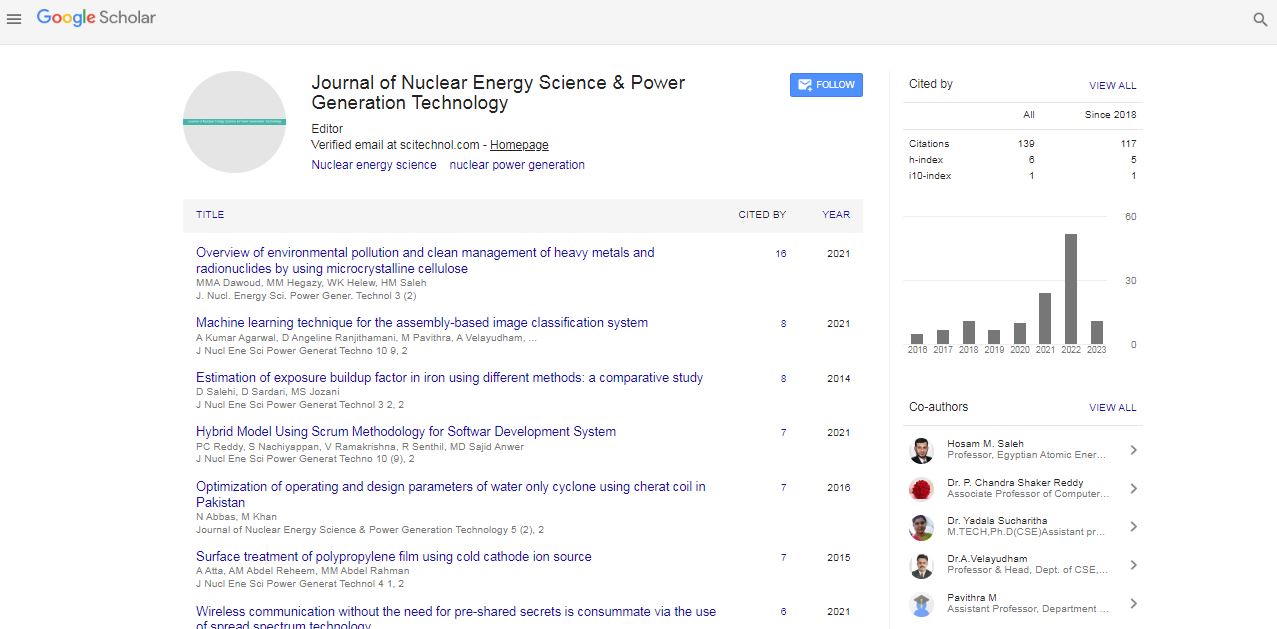Commentary, J Nucl Ene Sci Power Generat Technol Vol: 10 Issue: 7
Phases of Atomic Fuel Cycle
Natsumi Mitsuboshi*
Department of Information and Industrial Engineering, Yonsei University, Yonseiro, Seoul, Republic of Korea
*Corresponding author: Natsumi Mitsuboshi, Department of Information and Industrial Engineering, Yonsei University, Yonsei-ro, Seoul, Republic of Korea; Email: mitsuboshi@yonsei.ac.kr
Received date: 01 July, 2021; Accepted date: 10 July, 2021; Published date: 25 July, 2021
Keywords: Radioactive, Atomic Fuel
Introduction
Radioactive waste administration alludes to the protected treatment, stockpiling and removal of fluid, strong and gas release from atomic industry tasks determined to secure individuals and the climate. Radioactive misuse of different sorts results from any action that utilizes atomic materials, including clinical and modern employments. Nonetheless, thermal power is the main wellspring of such squanders due to the bigger volumes created and its extensive nature. Whatever their starting point, radioactive squanders must be overseen securely and monetarily. As a general rule, radioactive waste is isolated into three classes: low-level waste (LLW), halfway level waste (ILW) and significant level waste (HLW), contingent upon its degree of radioactivity and the timeframe it stays dangerous. Removal of LLW and most ILW is a full grown practice, while most HLW is securely put away in devoted offices. The perpetual removal of HLW in profound topographical storehouses is acknowledged to be practicable by the logical and specialized local area, however still can't seem to be acknowledged by common society in numerous nations. The NEA helps part nations in the advancement of protected, maintainable and culturally satisfactory methodologies for the administration of a wide range of radioactive waste. The NEA's Radioactive Waste Management Committee (RWMC) upholds individuals in the improvement of safe and financially productive administration of a wide range of radioactive waste including spent fuel considered as radioactive waste dependent on the most recent logical and innovative information. For radioactive waste, this implies confining or weakening it to such an extent that the rate or centralization of any radionuclides got back to the biosphere is innocuous. To accomplish this, essentially all radioactive waste is contained and overseen, with some obviously requiring profound and lasting entombment. From atomic force age, in contrast to any remaining types of warm power age, all waste is controlled – none is permitted to cause contamination. Atomic force is portrayed by the extremely huge measure of energy delivered from a tiny measure of fuel, and the measure of waste created during this cycle is additionally somewhat little. Nonetheless, a significant part of the waste delivered is radioactive and consequently should be painstakingly overseen as risky material. All pieces of the atomic fuel cycle produce some radioactive waste and the expense of overseeing and discarding this is important for the power cost. Radioactive waste is created at all phases of the atomic fuel cycle the way toward delivering power from atomic materials. The fuel cycle includes the mining and processing of uranium metal, its preparing and creation into atomic fuel, its utilization in the reactor, its reprocessing (whenever directed), the treatment of the pre-owned fuel taken from the reactor, lastly, removal of the waste. While squander is delivered during mining and processing and fuel manufacture, the larger part (as far as radioactivity) comes from the genuine 'consuming' of uranium to create power. Where the pre-owned fuel is reprocessed, the measure of waste is diminished physically. Atomic fuel is very energy thick, so very little of it is needed to deliver huge measures of power particularly when contrasted with other fuel sources. Subsequently, a correspondingly limited quantity of waste is created. By and large, the loss from a reactor providing an individual's power needs for a year would be about the size of a block. Just 5 grams of this is undeniable level waste about a similar load as a piece of paper. The age of power from an ordinary 1,000-megawatt thermal energy plant, which would supply the necessities of in excess of 1,000,000 individuals, creates just three cubic meters of vitrified undeniable level waste each year, if the pre-owned fuel is reused. In examination, a 1,000-megawatt coal terminated force station creates around 300,000 tons of debris and in excess of 6 million tons of carbon dioxide, consistently.
 Spanish
Spanish  Chinese
Chinese  Russian
Russian  German
German  French
French  Japanese
Japanese  Portuguese
Portuguese  Hindi
Hindi 

